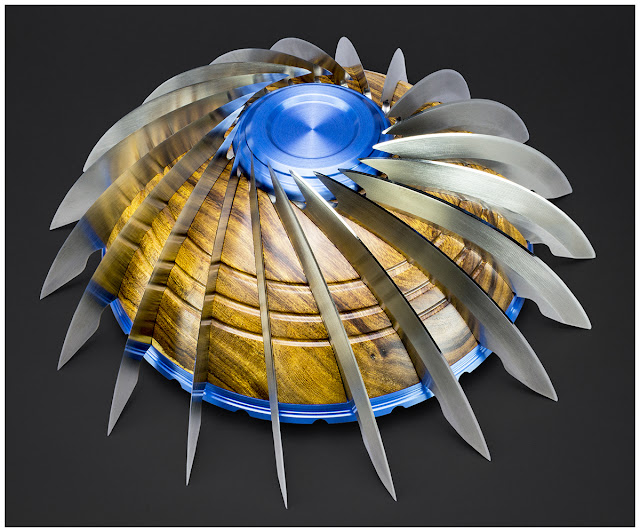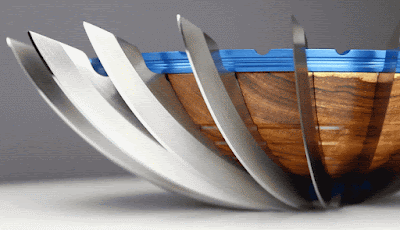Introducing the next installment in my “Sharp Arts” series, The "Sculptural Knife Bowl". It is a piece that combines elements of knife making and wood turning (and yes a big chunk of iron-nickel meteorite) into an object that is far more sculptural than it is functional.
If you are unfamiliar with my earlier project, The Sculptural Knife Vase, I highly recommend you visit it as the premise for this sculpture remains similar and I have written a tightly packed thesis for the whole project on that page.
But even if you don’t go back, I will adventure to flesh this out some here as well, there is always more to say, if in a slightly different way.
The premise for my sharp artworks series, simply put, is that machine-work is a medium that straddles a lot of worlds within the industrial and decorative arts. To properly understand machine-work as a sculptural medium, one needs to foster an appreciation for the way it intersects the fields of glass art, woodturning, ceramics and the other metal trades. Most of the industrial trades that have since been turned to various arts mediums have distinct craft forms that help define them.
These craft-forms are of interest to me because while machining is a craft that shares a similar industrial past, there are few signature forms one can point to that uniquely representative it as a medium.
The machinist landscape seems to lack ubiquitous forms that fall neatly into the paradigm of craft and craft-form.
Because of this absence of unique craft-forms within the world of machined metal, I have spent considerable time exploring what a “machined craft-form” might be. Should machining eventually find better standing as a sculptural medium, what forms might come to define it?
knife making and wood-turning have been front of mind for me a lot lately. I follow quite a few craftspeople within these fields who demonstrate manual dexterity and skill, as well as a thoughtfulness with materials that I find inspiring.
My appreciation for these makers has led me to believe that telling my story means telling their stories. To do this properly, I reasoned direct appropriation would not suffice. If I were to simply turn a bowl, then it wouldn’t be a commentary on woodturning, it would simply be an instance of that vocation. Likewise, making a traditional knife wouldn’t be recognizable as anything other than an exercise in knife making as well.
Why Woodturning?
Woodturning is a craft that most resembles aspects of my own process. Aside from the fact that woodturning is most often performed with hand guided tools instead of constrained by manual or automated machine motion, turning wood and turning metal have much in common.
When I meet woodturners there is instant kinship. They get my work instantly and the conversations quickly proceed to highly technical and interesting topics.
One of the most common craft forms within woodturning is bowl making, and so it seemed a natural fit for this project. Sometimes it is as simple as that.
Why knife making?
I have already written extensively about this over on the Sculptural Knife Vase post so I will just pull some quotes from there.
Knife making is a discipline that perfectly captures the dichotomy between historical and contemporary industrial processes. It is a field that mixes historic and modern methods and is that rare craft that maintains working “first hand knowledge” of nearly every technological step of its long history.
While its historical traditions are alive and well, the world of knife making has also been completely transformed by the adoption of modern machine tools and new technology.
Knife making’s influence on the creative culture of machine-work is undeniable. It has a long decorative arts tradition that has only grown with the adoption of digital fabrication technology. As a metal sculptor who is involved in the ways the process can inform the aesthetic elements of a craft, knife making is beyond fascinating to me.
I found it difficult to approach the craft directly through my work. My process typically involves stripping away the utility from various design or craft concepts to better reveal what is aesthetically interesting about them. However it occurred to me that it isn’t necessary to fully strip the utility from a knife to appreciate its inherent aesthetic qualities; one can simply put those qualities into a unique context.
The knife bowl?
Creating a distinct and impractical Bowl might seem an odd way to explore woodturning and knife making together, but as with the Sculptural Knife Vase (above), using blades as sculptural elements creates an interesting contrast that elevates what would otherwise be utilitarian forms into something to be appreciated aesthetically. It is the best way I know of to get people to stop and consider what the decorative arts have given to the creative arts and vice versa.
I am committed to periodically visiting this tangent in my work as time permits. When I sketched out a plan for this series, I made three designs, two of which I have now made.
Time will tell whether or not I get around to the third and final piece in this saga, but no doubt these experiences will find expression elsewhere in my work.
Process notes:
I have folded in many of the technical elements I learned over the last few years. I spent the better part of last year making sculptures with components that were turned from various exotic hardwoods. My approach to the blades was also heavily informed by my previous work.
The body of the bowl is turned in Desert Ironwood, which is actually a common knife making material, but not one you often find in a wood turning studio. Likewise, I couldn't resist the urge to include a large piece of machined iron nickel meteorite (a very exotic knife making material with historical roots) as the focal point for the bottom of the bowl.
(See here for more details on the use of meteorite in knife making)
I documented some, but not all, of my work on this one. I was juggling a few projects and so I was spotty with the camera for a bit. Above is what I was able to capture. I hope it is at least partially illuminating (if incomplete).
As always, questions and comments are welcome.










